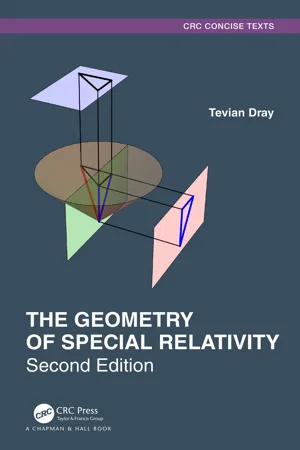
- 174 pages
- English
- ePUB (mobile friendly)
- Available on iOS & Android
The Geometry of Special Relativity
About this book
This unique book presents a particularly beautiful way of looking at special relativity. The author encourages students to see beyond the formulas to the deeper structure.The unification of space and time introduced by Einstein's special theory of relativity is one of the cornerstones of the modern scientific description of the universe. Yet the unification is counterintuitive because we perceive time very differently from space. Even in relativity, time is not just another dimension, it is one with different propertiesThe book treats the geometry of hyperbolas as the key to understanding special relativity. The author simplifies the formulas and emphasizes their geometric content. Many important relations, including the famous relativistic addition formula for velocities, then follow directly from the appropriate (hyperbolic) trigonometric addition formulas.Prior mastery of (ordinary) trigonometry is sufficient for most of the material presented, although occasional use is made of elementary differential calculus, and the chapter on electromagnetism assumes some more advanced knowledge.
Changes to the Second Edition
-
- The treatment of Minkowski space and spacetime diagrams has been expanded.
-
- Several new topics have been added, including a geometric derivation of Lorentz transformations, a discussion of three-dimensional spacetime diagrams, and a brief geometric description of "area" and how it can be used to measure time and distance.
-
- Minor notational changes were made to avoid conflict with existing usage
in the literature.
Table of Contents
Preface
1. Introduction.
2. The Physics of Special Relativity.
3. Circle Geometry.
4. Hyperbola Geometry.
5. The Geometry of Special Relativity.
6. Applications.
7. Problems III.
8. Paradoxes.
9. Relativistic Mechanics.
10. Problems II.
11. Relativistic Electromagnetism.
12. Problems III.
13. Beyond Special Relativity.
14. Three-Dimensional Spacetime Diagrams.
15. Minkowski Area via Light Boxes.
16. Hyperbolic Geometry.
17. Calculus.
Bibliography.
Author Biography
Tevian Dray is a Professor of Mathematics at Oregon State University. His research lies at the interface between mathematics and physics, involving differential geometry and general relativity, as well as nonassociative algebra and particle physics; he also studies student understanding of "middle-division" mathematics and physics content. Educated at MIT and Berkeley, he held postdoctoral positions in both mathematics and physics in several countries prior to coming to OSU in 1988. Professor Dray is a Fellow of the American Physical Society for his work in relativity, and an award-winning teacher.
Frequently asked questions
- Essential is ideal for learners and professionals who enjoy exploring a wide range of subjects. Access the Essential Library with 800,000+ trusted titles and best-sellers across business, personal growth, and the humanities. Includes unlimited reading time and Standard Read Aloud voice.
- Complete: Perfect for advanced learners and researchers needing full, unrestricted access. Unlock 1.4M+ books across hundreds of subjects, including academic and specialized titles. The Complete Plan also includes advanced features like Premium Read Aloud and Research Assistant.
Please note we cannot support devices running on iOS 13 and Android 7 or earlier. Learn more about using the app.
Information
1
Introduction
1.1 Newton's Relativity
1.2 Einstein's Relativity
2
The Physics of Special Relativity
2.1 Observers and Measurement
2.2 The Postulates of Special Relativity
Table of contents
- Cover
- Half Title
- Series Page
- Title Page
- Copyright Page
- Dedication
- Contents
- Preface
- List of Figures
- List of Tables
- 1 Introduction
- 2 The Physics of Special Relativity
- 3 Circle Geometry
- 4 Hyperbola Geometry
- 5 The Geometry of Special Relativity
- 6 Applications
- 7 Problems I
- 8 Paradoxes
- 9 Relativistic Mechanics
- 10 Problems II
- 11 Relativistic Electromagnetism
- 12 Problems III
- 13 Beyond Special Relativity
- 14 Three-Dimensional Spacetime Diagrams
- 15 Minkowski Area via Light Boxes
- 16 Hyperbolic Geometry
- 17 Calculus
- Bibliography
- Index